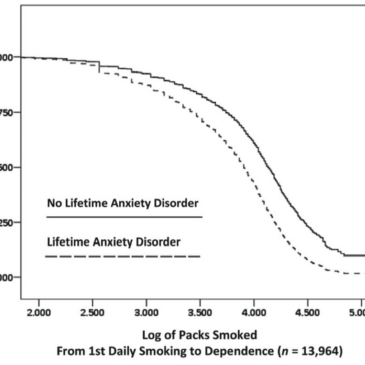Many factors can influence how quickly a person transitions from the first cigarette to nicotine dependence, if the transition occurs at all. Anxiety disorders, in particular, might be involved in “telescoping” (i.e., transitioning relatively quickly from recreational use to dependence). A recent WAGER reviewed a study that showed similar telescoping effects of gender and anxiety on the development of pathological gambling. This week’s ASHES reviews a study investigating whether anxiety disorders accelerate the transition between the onset of smoking and onset of nicotine dependence (Kushner, Menary, Maurer, & Thuras, 2012). Kushner and colleagues predicted that individuals with an anxiety disorder would transition to nicotine dependence after smoking fewer total cigarettes than did individuals without an anxiety disorder.
Methods
- This study uses data collected as part of the National Epidemiologic Survey on Alcohol and Related Conditions (NESARC; Grant, Stinson, Dawson, Chou, Dufour, Compton, …, Kaplan, 2004).
- The study population consisted of the 18,103 NESARC participants who reported smoking at least 100 cigarettes during his or her lifetime.
- As part of the NESARC, participants completed the Alcohol Use Disorder and Associated Disabilities Interview Schedule IV (AUDADIS), a structured interview assessing a variety of psychological disorders including anxiety disorders. They also reported on their smoking
habits. - The authors estimated how many packs of cigarettes people smoked before becoming dependent on nicotine. To do this, they first determined the number of years between the reported (1) initiation of regular smoking[1] and (2) onset of nicotine dependence[2]. They multiplied the number of years by the amount of packs participants reported smoking per year.
- Researchers then entered these data into a model to assess the risk of developing nicotine dependence per pack of cigarettes, and compared the risk between those with and without anxiety disorders.
- Researchers controlled for various covariates, including use of other tobacco products.
Results
- Compared with participants without anxiety disorders, participants with anxiety disorders smoked approximately 70 more packs per year.
- Participants with at least one anxiety disorder smoked fewer cigarettes before transitioning from regular smoking to nicotine dependence compared to those without anxiety disorders (Harm ratio = 1.73, 95% Confidence Interval (CI) [1.66, 1.80]).
- Participants who had more than one anxiety disorder (e.g., PTSD and generalized anxiety disorder) transitioned to nicotine dependence after smoking fewer cigarettes than both participants with only one anxiety disorder (HR = 1.80, 95% CI [1.71, 1.90]) and participants with no anxiety disorders (HR = 1.49, 95% CI [1.42, 1.56]).
Figure. Survival function depicting development of nicotine dependence grouped by anxiety disorder status (reprinted with permission from Kushner, Menary, Maurer, & Thuras, 2012). Click image to enlarge.
Limitations
- This study relies on retrospective data. The NESARC and AUDADIS require participants to report their behaviors in the past, and these reports might be inaccurate.
- Although the analysis controlled for several other tobacco products, it did not control for transdermal nicotine use (e.g., nicotine patches).
- The study relies on a single estimate of cigarettes smoked per year to determine the number of cigarettes smoked between
the onset of regular smoking and nicotine dependence. This figure can change drastically according to habits and tolerance.
Discussion
The results of this study suggest that people with anxiety disorders transition from regular smoking to nicotine dependence after smoking fewer cigarettes than those without anxiety disorders; when participants had more than one anxiety disorder, this effect was bigger. Those with anxiety
disorders might be more susceptible to developing dependence, and therefore each pack can be thought of as more ‘risky’ for those with anxiety disorders. The authors hypothesize that because anxiety disorders and nicotine abuse operate through similar pathways in the brain (Koob, 2003), those with anxiety disorders might be more vulnerable to developing nicotine dependence. This research may encourage doctors and psychologists to provide stronger nicotine warnings to their patients suffering from anxiety disorders.
– Daniel Tao
References
Grant, B.F., Stinson, F.S., Dawson, D.A., Chou, S.P., Dufour, M.C., Compton, W., …, Kaplan, K. (2004). Prevalence and co-occurrence of substance use disorders and independent mood and anxiety disorders: Results from the National Epidemiological Survey on Alcohol and Related Conditions. Archives of General Psychiatry, 61, 807-816.
Koob, G.F., Le Moal, M. (2008). Addiction and the brain antireward system. Annual Review of Psychology, 59, 29-53. Kusher, M.G., Menary, K.R., Maurer, E.W., Thuras, P. (2012).
Greater elevation in risk for nicotine dependence per pack of cigarettes smoked among those with an anxiety disorder. Journal of Studies on Alcohol and Drugs, 73, 920-924.
What do you think? Please use the comment link below to provide feedback on this article.
________________






yair Reznik January 7, 2013
Is all addictions, without exception, anxiety and depression play a very important role. I made it very clear in my book titled gambling addiction handbook.
Sincerely,
Yair